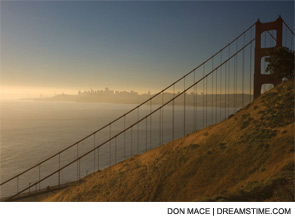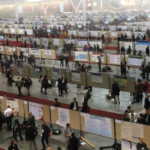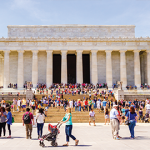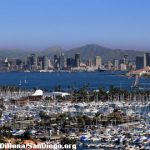
Wasn’t the 2008 ACR/ARHP Annual Scientific Meeting great? Terrific science, record attendance, and a magnificent setting. San Francisco is a glorious place that provides some of the most striking vistas in the world as the bay sparkles against a curtain of dense white fog that is both mysterious and entrancing.
Alas, the setting is not perfect because San Francisco sits precariously on a geological fault line whose tectonic movements may one day produce The Big One, a mammoth earthquake that will catapult the city into the sea. The big quake of 1906 produced unbelievable devastation, but there were no building codes then and a much smaller tremor could have toppled many of those rickety wood structures. Fortunately, engineering whizzes today can produce buildings that can withstand even the most severe seismic shake, rattle, and roll.

A Year for Big Ones
When I am in San Francisco, my worries about The Big One usually subside after a stroll along the Embarcadero or after taking a few sips of a Napa chardonnary that tickles my tongue with notes of citrus and butterscotch. This year, however, worries about The Big One did not go away. Indeed, like many attendees at the ACR meeting, my mind was besieged by worries of other “big ones,” in addition to the one created by the slippage of the San Andreas Fault.
What were these “big ones”? I will name only three: 1) the election; 2) the worldwide financial collapse; and 3) the impact of the changing political and economic landscape on the future of rheumatology.
I am sure that I was not alone in feeling buffeted by events of the past weeks as the professional ground below me began to rumble. I was hoping that, during a session at the Moscone Center, a question on one of the big ones would appear in one of those audience surveys in which a speaker puts up a question, a digital clock marks the 10-second countdown, and a snippet of famous music plays as the attendees push little buttons to make their choices. Every time I saw one of those surveys, I thrilled as the computer magically calculated the votes and generated a bar graph in nifty colors like magenta and cyan that glowed from the screen.
I can imagine such a question. “Which of the following do you think will affect the financial future of you and your practice: A) the stock market; B) new taxes; C) changing reimbursement; D) all of the above; or E) none of the above?” I think that most everyone would have answered, “D.”
In all of my years at ACR meetings, I have never witnessed so much talk about an election nor the display of so many campaign buttons and t-shirts. I suspect that some people from red states could, in the city of San Francisco—a preserve of blue political sentiments par excellence—raise their political voices and, in the tradition of the city in another realm, come out of the closet, so to speak.
Perhaps my political leanings are apparent, but just about everyone to whom I spoke assumed that I supported Obama and that “we” represented the rheumatology wing of the Democratic Party. I felt that same way I do the week before the Duke–Carolina basketball game when someone at the medical center says that “we” are going to win. Of course, “we” are the Blue Devils and there is no way in hell that “we” could be the despised, reviled, and contemptible Tar Heels.
Ambivalence at Home and Abroad
Not surprisingly, the ACR contingent from Europe was just about all in favor of Obama. In most of the countries there, even the most conservative parties stand to the left of our liberals. The Europeans are social democrats after all and, while private healthcare insurance may be growing, the European countries all have tax-funded universal healthcare coverage. I did not meet any Russians in San Francisco. It’s too bad that they don’t come to spend their petro-rubles on real CME, because an exchange with that colossus would be very worthwhile.
The interest of the Europeans in U.S. politics is not a matter of idle curiosity. The world is flat as a pancake; witness the financial ripples around the world because of the failure of Iceland’s banks. In a global economy, where all transactions are linked electronically at lightning speed, when the U.S. catches a cold, everyone sneezes. Right now there is a whole lot of sneezing going on. If I had money to invest, I would take a strong position in Kleenex stock.
As evident in myriad conversations, remarks, and even jokes, just about everyone at the ACR was worried that, economically, we may be in the midst of a “big one.” During sessions in the dark of the giant halls, people peered down at the flickering screens of their BlackBerries and iPhones to catch the latest on the Dow Jones Index as the stock market bounced wildly. More than one lecturer talked about the state of his 401(k). As a scientist at an ACR meeting, when I hear the words “401K,” I usually think of a really big protein and not a retirement plan.
Despite the mad gyrations of Wall Street, the dire warnings of an imminent financial meltdown, San Francisco seemed to have a Zippity Do Da attitude. The streets were filled with people who walked briskly to their jobs in soaring highrises. Avid shoppers, their pockets stuffed with euros, filled Nieman Marcus looking for bargains, and the restaurants were bursting. While ACR attendees may have filled some of the seats, the natives were there in force, and that was not a bottle of Gallo at the table. No, that bottle was a rare and ethereal pinot noir crafted from grapes from a steep, fog-embraced slope. The nose of the wine was redolent of cherries and that little puppy cost 200 smackers.
Always cautious, I had thrift on my mind. On the front desk of my hotel was a shiny silver bowl filled with the best Granny Smith apples you ever saw. Each day, I took an apple for an afternoon snack but I never ate one. By the end of the week, my black bag was filled with apples. While feeling sheepish about this fruit collection, I was reassured that, if the stock market really tanked, I could set up shop on Market Street, ready to sell those Granny Smiths to make ends meet.
The ACR meeting inspired me with optimism and good humor, especially as I saw all those young trainees who looked bright-eyed and bushy-tailed and seemed keen to learn. Nevertheless, a “big one” may be around the corner and, in my next column, I will provide further musings from the ACR meeting on the future of rheumatology.
Dr. Pisetsky is physician editor of The Rheumatologist and professor of medicine and immunology at Duke University Medical Center in Durham, N.C.


